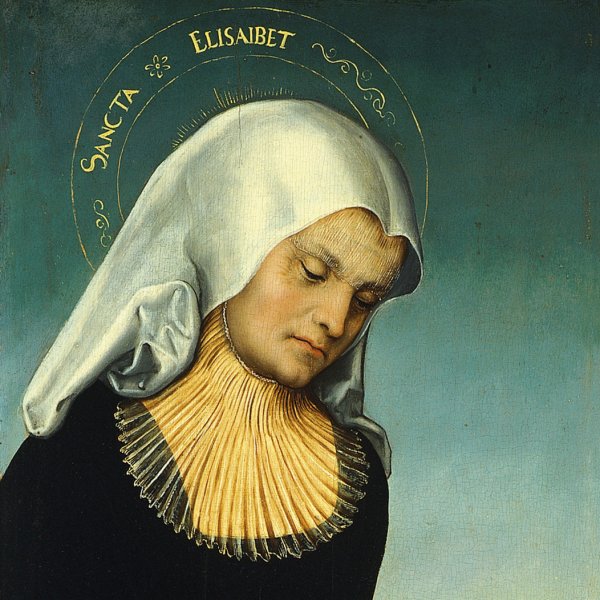Triptych of the Rosary
Hans Kulmbach was a painter and designer of prints whose career was closely associated with the city of Nuremberg. The present triptych takes its name from the central, circular motif of flowers with the Five Mysteries indicated by crosses. Kulmbach’s painting emphasises the importance of reciting the rosary for earning indulgences and achieving salvation. Inside the rosary motif is the crucified Christ flanked by the Virgin and Child, angels and the Blessed, among other figures, while two angels complete the composition at the top, holding up the wheel of the rosary. On the left wing of the triptych Kulmbach has depicted The Presentation of the Virgin in the Temple while on the right is The Meeting at the Golden Gate. In its present state this work is a reconstruction, the precise date of which is unknown but which must have taken place in the 19th century. The lateral doors are later than the central panel and can be associated with an altarpiece on the Life of the Virgin that was described in 1778 as being in a castle in Nuremberg. The central panel is executed in a more calligraphic style and dates from prior to 1510. Kulmbach repeated it in a print of 1515.
It would seem that Hans Kulmbach arrived in Nuremberg from Upper Franconia around 1504–5 and was granted citizenship in 1511. According to Johann Neudörffer and Joachim von Sandrart, his early works reveal the influence of the Italian painter Jacopo de’ Barbari who was court painter to the Elector Frederick the Wise, and of Dürer, in whose studio he may have worked around 1505. Kulmbach was one of the most important artists working in Nuremberg in the first decades of the 16th century and within his oeuvre his altarpieces and designs for illustrations are particularly notable both in terms of number and quality. Together with Baldung Grien, Kulmbach was one of the most outstanding painters of Dürer’s circle.
The Triptych of the Rosary was in the Rohoncz collection in 1930, by which date it had acquired the form in which it is currently seen. The triptych was acquired from the Fleischmann gallery in Munich after the exhibition at the Neue Pinakothek closed, and it is recorded and reproduced in the Collection’s catalogues from 1937. The triptych was formerly in the collection of Prince Thurn und Taxis in Ratisbon, which is its oldest known provenance.
As seen today, the triptych is an assemblage made at an unknown date but which must have been constructed in the 19th century. The three panels are all undoubtedly by Kulmbach but were painted at different times. The central panel, with its more calligraphic style, has been dated to slightly prior to 1510 while the lateral wings, which originally formed part of the same altarpiece, date from 1513. The Gothic tracery framing the upper part of the lateral panels is not of the period and was added when the three panels were joined together. At this point the lateral panels were attached in the wrong order to the central panel. Following the normal chronology of the Life of the Virgin, The Embrace at the Golden Gate should be the left wing and The Presentation of the Virgin in the Temple should be the right one. The correct position of these two scenes would produce a better overall composition with a more coherent termination on the right.
The central panel depicts a theme that has numerous precedents in Franconian art. The composition highlights the importance of the rosary and its accompanying prayers for achieving salvation and gaining indulgences, as indicated by inscriptions on other compositions on this subject. The rosary is depicted as a circle held up by two angels and bordered by flowers with the Five Mysteries marked by crosses. The inside is divided into sections on either side of Christ on the cross who forms part of a vertical axis of the Holy Trinity, completed by God and the Holy Spirit in the form of the Dove. In the area above the cross we see the Virgin crowned as Queen of Heaven with the Christ Child in her arms. In the lower zone Kulmbach arranged three lines of figures. In the upper line from left to right we see Aaron, lacking his usual iconographic symbols, David with his harp and crown, Moses with his horn and the Tablets of the Law, and Saint John the Baptist with the lamb. On the other side of the cross is Saint Peter with his key, Saint Paul with his sword, Saint Mark (?) lacking any attribute, and Saint Luke with his bull. In the centre is Saint Lawrence with his gridiron, Saint George in armour, Saint Erasmus with the winch with his entrails, and Saint Stephen with a book and stones. On the right are a pope, a cardinal, a bishop and a king. The lower line has female saints. Saint Clare with the Host, an unidentified female saint without attributes, Saint Barbara with the chalice, and Saint Catherine with the broken wheel. On the other side is the Triple Anna, Mary Magdalen with her pot of ointment, and Saint Helena with the cross. Below the circle we see Saint Michael weighting souls next to a vision of purgatory.
The lateral wings depicting The Embrace at the Golden Gate and The Presentation of the Virgin in the Temple were originally the interior wings of a polyptych whose central element was a sculptural group of The Coronation of the Virgin, now in the Nationalmuseum, Nuremberg. This now dismembered Marian altarpiece has been hypothetically reconstructed with some variations. The predella included a Death of the Virgin, now in the Staatsgalerie, Bamberg. The altarpiece was previously in theWalburgiskapelle in Nuremberg Castle.
Mar Borobia









